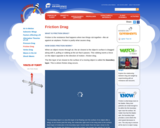
What is friction drag?
- Subject:
- Physical Science
- Material Type:
- Activity/Lab
- Provider:
- National Air and Space Museum
- Author:
- National Air and Space Museum
- Date Added:
- 09/14/2022

What is friction drag?

This unit explores Performance Expectations MS-PS2-1, 2-2, 3-1, 3-5 and ETS1-4 via an engineering challenge to design the most efficient wind turbine. Students are pressed to explain why and how wind surfers are able to catch so much wind!

The University of Iowa Center for Global and Regional Environmental Research and College of Education teamed up to develop free eighth grade science curricula on land use and climate science, in response to Iowa’s grade level alignment of the middle school Next Generation Science Standards.
Primary author Dr. Ted Neal, clinical associate professor of science education, led a team of graduate and pre-service teaching students and CGRER scientists to develop the material. They grouped standards, resources and lesson material into six bundles, each designed to engage Iowa’s middle schoolers with local data and information on relevant topics like athletic concussions and agriculture.
These lessons are built on NGSS principles and put learning in the students’ hands with hands-on activities for groups and individuals. Kids will have ample opportunity to get curious, generate questions and lead themselves to answers.

Without air, balloons and birds and airplanes couldn't fly. But since you can't taste, see, or often even feel air, how can you prove it's really there?
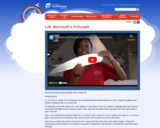
Find out how Bernoulli's principle helps explain lift.
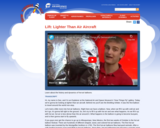
Learn about the history and dynamics of hot-air balloons.

Do you ever dream of being able to fly? The good news is, you probably can! The bad news is that you can't fly very high or stay up for very long

Phenomena:A car has run out of gas on the railroad tracks. It is stopped in the middle of the tracks and is blocking the lane. An oncoming train sees the car, applies the brakes but cannot stop and crashes into the parked car. Storyline: Students are playing with toys and notice that each time one car is moving and runs into another object that is not moving, the second object moves. Sometimes it moves far and other times it only moves a short distance. The students want to find out why toys move various distances when objects come into contact with it. PE Alignment: MS-PS2-1 Apply Newton’s Third Law to design a solution to a problem involving the motion of two colliding objects. MS-PS2-2 Plan an investigation to provide evidence that the change in an object’s motion depends on the sum of the forces on the object and the mass of the object.Image source: "UP 5525 Crosses Washington Street in West Chicago" by vxla at https://www.flickr.com/photos/vxla/4614440328 CC BY 2.0 (https://creativecommons.org/licenses/by/2.0/)
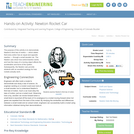
The purpose of this activity is to demonstrate Newton's third law of motion which states that every action has an equal and opposite reaction through a small wooden car. The Newton cars show how action/reaction works and how the mass of a moving object affects the acceleration and force of the system. Subsequently, the Newton cars provide students with an excellent analogy for how rockets actually work.
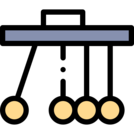
This resource is designed to align with the UT SEED standard 7.1, Forces and interactions between matter. it specifically introduces the definition of Newtons third law of motion. Students will be looking at three different systems; rocket launch, swimming, and walking. They will observe and identify the direction and motion of forces within these systems. by looking at patterns of the direction of force and the direction of motion, they will come to the conclusion that every action in these systems has an opposite reaction.
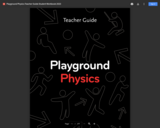
Playground Physics is an iPad and Progressive Web application (app) developed by the New York Hall of Science. The app is accompanied by a supplemental Teacher Guide for middle school teachers. The Playground Physics curriculum is a six-week supplemental physics curriculum, designed to be used alongside any existing science curricula in the middle grades. It includes a teacher guide and student work, and maps to the NGSS and NYSSLS. The curriculum is focused around three different units which each explore a major concept in physics (motion, force and energy) through a specific type of physical play (catching a ball, jumping, swinging).
Playground Physics is particularly well suited to supporting diverse learners because it leverages students’ abilities to playfully ask and answer their own questions to connect academic content to what they notice, describe and analyze about their own individual actions. Additionally, the multimodal nature of the program, which uses videos and images as well as kinesthetic exploration to build understanding, is less text-dependent than more traditional physics instructional materials.
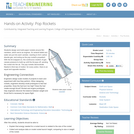
Students design and build paper rockets around film canisters, which serve as engines. An antacid tablet and water are put into each canister, reacting to form carbon dioxide gas, and acting as the pop rocket's propellant. With the lid snapped on, the continuous creation of gas causes pressure to build up until the lid pops off, sending the rocket into the air. The pop rockets demonstrate Newton's third law of motion: for every action, there is an equal and opposite reaction.
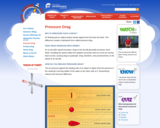
Learn about pressure drag and how it affects flight
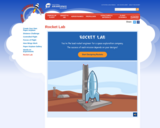
Build your own rocket and complete a mission.
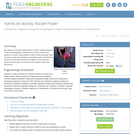
By making and testing simple balloon rockets, students acquire a basic understanding of Newton's third law of motion as it applies to rockets. Using balloons, string, straws and tape, they see how rockets are propelled by expelling gases, and test their rockets in horizontal and incline conditions. They also learn about the many types of engineers who design rockets and spacecraft.
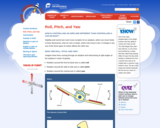
Stability and control are much more complex for an airplane, which can move freely in three dimensions. Learn about roll, pitch, and yaw.

Join STEM in 30 as we trace the family tree of the airplane from that first flight on December 17, 1903, to today.

Why are airplane wings shaped the way they are? What can pretzels tell you about flying? Instead of catching a nap or flipping through the in-flight magazine, do some experiments next time you fly.
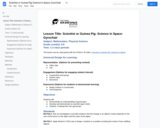
Students explore Newton's Third Law of Motion through a gyro-chair activity.
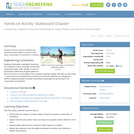
Students examine collisions between two skateboards with different masses to learn about conservation of momentum in collisions.